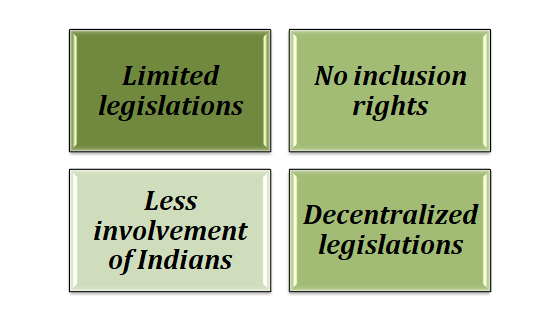

Indian Councils Act 1861 was adopted in the United Kingdom Parliament that changed the definition of the Governor General Council for the executive and legislative objectives. The most significant element of the act was Indian participation in the process of legislation. This act changed India’s executive council to work as a cabinet run on the portfolio system. The main purpose to introduce this law was that the British government wanted to entangle the people of India in the law-making process. This act was adopted on 1st August 1861.
Indian councils Act 1861 was a type of act adopted by the British parliament that significantly changed the definition of law in the Governor General council. The power of this act altered the viceroy’s executive council into a tiny cabinet on the portfolio system. This act also changed the 5 ordinary members of the Calcutta government to the various departments like home, finance, revenue, law and military.
The act 1861 of the Indian council set the chief military commander as an unrestrained member (legislative, 2022). This member was a special member who was placed on an executive council of the viceroy to regulate the general works department which is later called commerce and industry. The charge of the foreign department was given to the governor-general.
The historical revolt that took place in 1857 totally stirred the government of the British. This revolt compelled the British Government to search for a type of corporation with the people of India in the administration. The British Government exercised total control of the territory of India and then they settled to recast the legislative and executive structures. After that, three acts were adopted, that is 1861, 1892 and 1909.
The act of 1858 of the Government of India brought many significant changes in the method of the British Government. After the enactment of this act, the British government thought that the act brought a vital change to the government system of India but it did not work properly. After the 1857 revolt, the British Government realised that it was impossible to create an act without the people of India and their participation in the administration. The charter act of 1833 regulated only the process of legislation. Through this act, there was one representative to control every four regions, but this regulation act was not accepted by the people of India. The procedures were too long that the Governorgeneral of the council was failed and unable to control the action.
There were some provisions of this act that −
The viceroy Lord Canning and the Governor-general established the portfolio system in which every member was employed with a portfolio of a department.
The works for the executive council and legislative purposes there must be appointed members not less than 6 and not higher than 12. Those members were named as the additional members of the Executive council and among those members half members were non-official.
The power of nomination of those members had been given by the governor-general for two years.
Lord Canning named 3 members for the Executive council. The members are Sir Dinkar Rao, the Raja of Banaras, and the Maharaja of Patiala.
Different types of bills were concerned with public debt, religion, foreign affairs and military. Those bills were only could pass through the sign of the Governor General.
The power of propagation of the ordinances at the time of the emergencies had been given to the Governor General without the compliance of the council.
The power for British India’s procedure with the law had been given to the legislative of Calcutta.
The Indian Councils Act of 1861 was a turning point in the history of India’s constitutes and politics. The formation of the Council of the governor-general had been changed for the process of legislation. There began a new procedure for representative institutions by employing the Indians in the process of legislation, was established. The power of execution and legislation of the presidencies of Madras and Bombay was restored through this act. The act brought the power to the presidency of Calcutta of making laws for British India.

Criticisms of Indian Councils Act 1861
This act also had various defects or demerits.
The role of the Council of legislation was limited. They did not take any decisions on finance. Generally, it was advisory.
The people of India were elected though; they had no right officially for the retention of Indians .
The main power remained only for the Governor General.
The power of legislation of Bombay and Madras decentralised the legislature power.
Many bills passed without the discussion of the member of India and they could not oppose the discussion.
Indian councils Act 1861 brought a revolutionary effect in the constitution of British India. It created a landmark in the political history of India. The people of India got the allocation to interfere with the act of the constitution. This act helped to provide a better structure for the Council’s Constitution of the Governor-general of India. This act also had many defects that were realised by the people of India later. The act 1861 of the Indian council brought a significant alternation and the vital benchmark of the constitution and the Indian history.
Q.1. What was the main objective of the Indian councils Act 1861?
Ans. The actual objective of this act was to enter the Indian administration. After the 1857 revolt the British Government brought this act to India.
Q.2. Who introduced the portfolio system in the Indian councils Act 1861?
Ans. The portfolio system of this act was objected to by Lord Canning. He was the first Viceroy of India.
Q.3. What was the meaning of the ordinances that were introduced in the Indian Council Act of 1861?
Ans. The ordinances are the law which was enacted in the emergency situation and was created by the Viceroy. These types of ordinances were valid for 6 months after enactment.